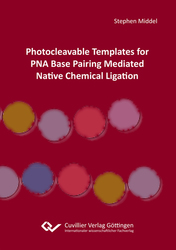| Departments | |
|---|---|
| Book Series (96) |
1378
|
| Nachhaltigkeit |
3
|
| Gesundheitswesen |
1
|
| Humanities |
2364
|
| Natural Sciences |
5406
|
| Mathematics | 229 |
| Informatics | 319 |
| Physics | 980 |
| Chemistry | 1363 |
| Geosciences | 131 |
| Human medicine | 243 |
| Stomatology | 10 |
| Veterinary medicine | 108 |
| Pharmacy | 147 |
| Biology | 835 |
| Biochemistry, molecular biology, gene technology | 121 |
| Biophysics | 25 |
| Domestic and nutritional science | 45 |
| Agricultural science | 1004 |
| Forest science | 201 |
| Horticultural science | 20 |
| Environmental research, ecology and landscape conservation | 148 |
| Engineering |
1793
|
| Common |
98
|
|
Leitlinien Unfallchirurgie
5. Auflage bestellen |
|
Advanced Search
Photocleavable Templates for PNA Base Pairing Mediated Native Chemical Ligation (English shop)
Stephen Middel (Author)Preview
Extract, Datei (1.6 MB)
Table of Contents, Datei (690 KB)
The modification of proteins is a fundamental task in natural sciences in order to control and to understand biochemical processes. To address more complicated targets and to widen the spectrum of possible modifications, it is necessary to develop new strategies and to expand the established techniques. Herein, a novel PNA base pairing guided ligation strategy applying photocleavable templates is presented. This strategy implies the design of PNA/peptide hybrids, which are connected via a photocleavable linker. Sequence specific assembly of two PNA/peptide hybrids can be achieved by PNA base pairing. Thereby, the reactive centers are brought in close proximity and a ligation between the two hybrids is facilitated. Finally, the guiding units can be cleaved by irradiation with UV light.
| ISBN-13 (Hard Copy) | 9783736993549 |
| ISBN-13 (eBook) | 9783736983540 |
| Final Book Format | A5 |
| Language | English |
| Page Number | 162 |
| Lamination of Cover | matt |
| Edition | 1. |
| Publication Place | Göttingen |
| Place of Dissertation | Göttingen |
| Publication Date | 2016-09-16 |
| General Categorization | Dissertation |
| Departments |
Chemistry
Organic chemistry |
| Keywords | peptide ligation, templated reactions, photocleavable linker, peptide nucleic acid, native chemical ligation |








